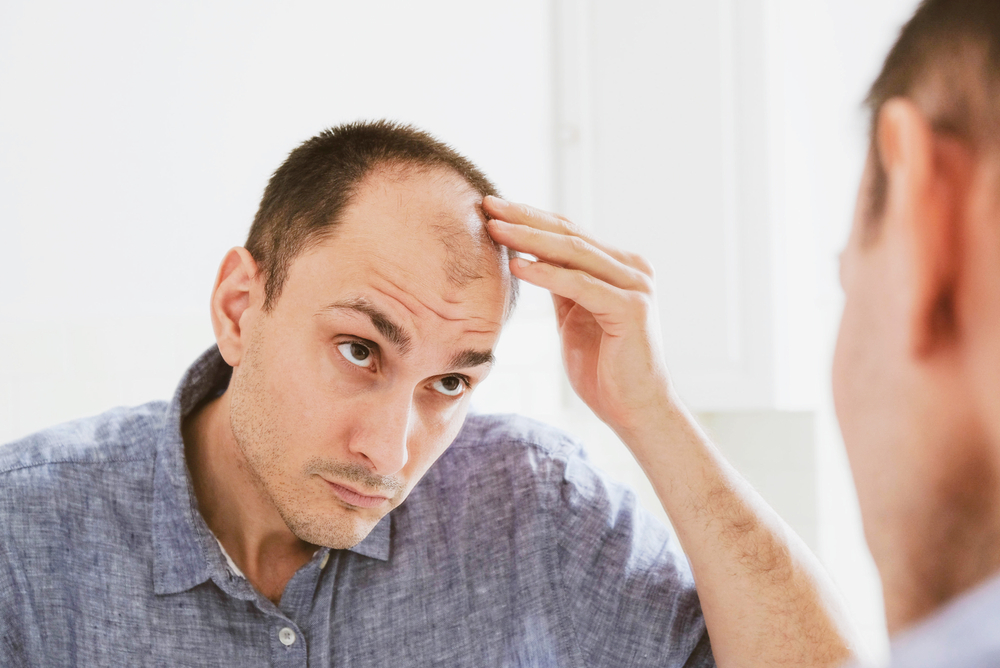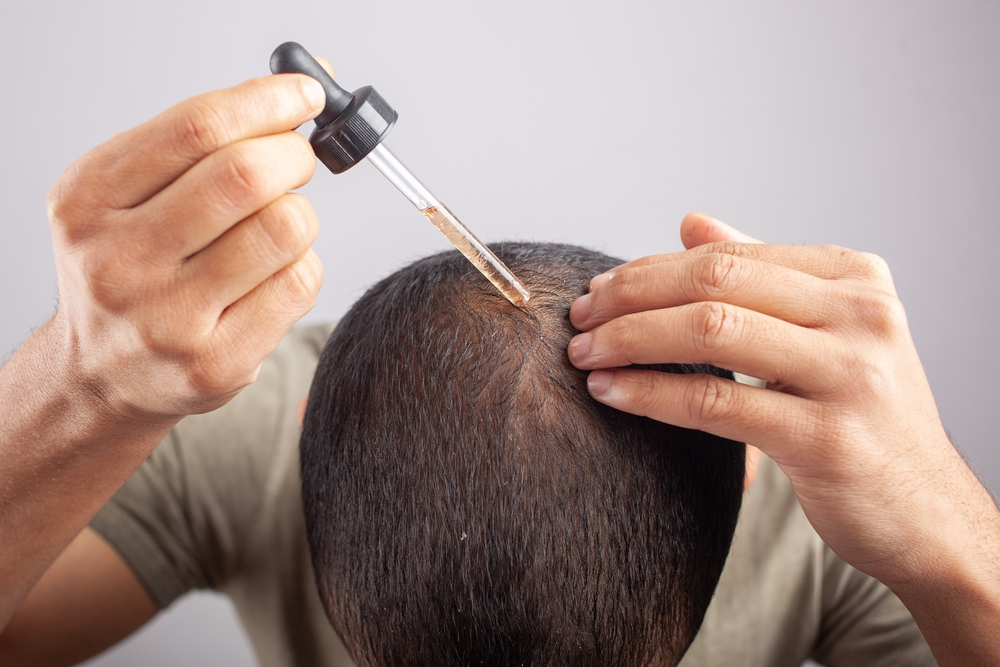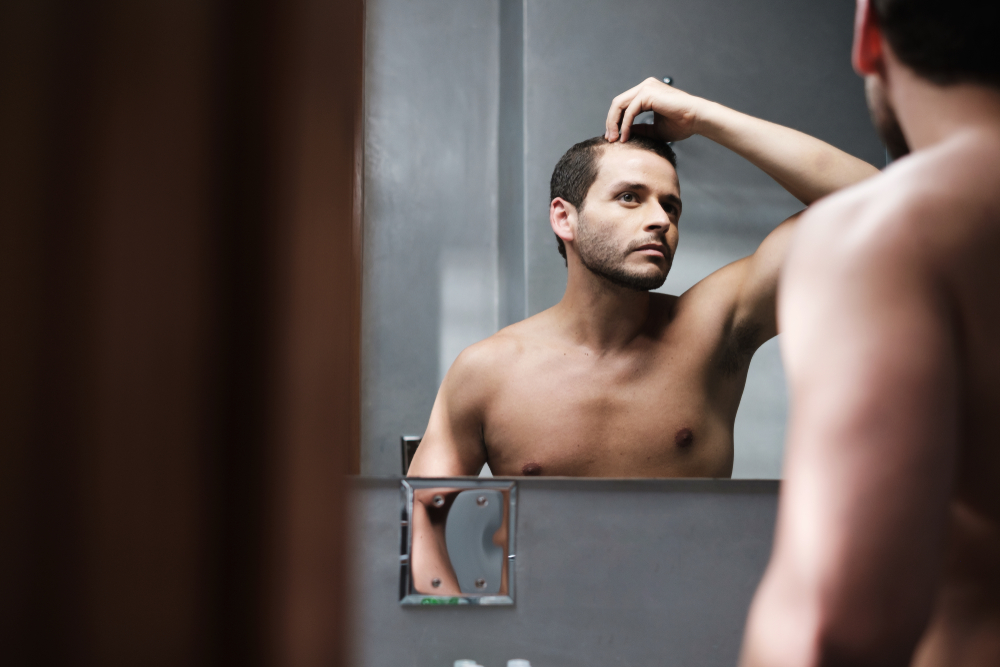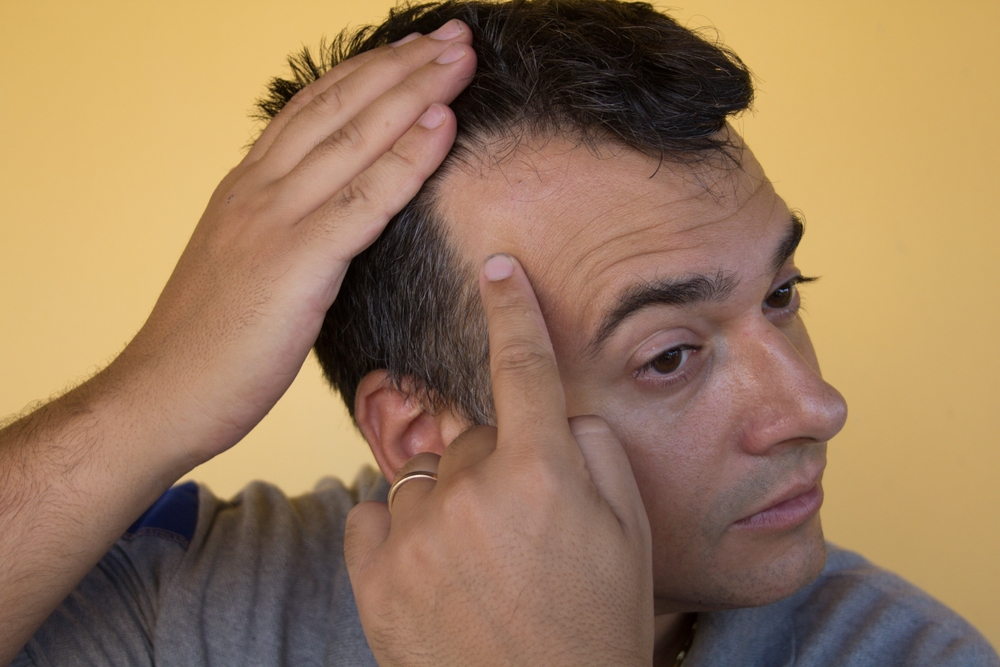What causes a receding hairline?
For the overwhelming majority of men, a receding hairline will be due to male pattern baldness (MPB), also known as androgenetic alopecia (or androgenic alopecia). MPB is caused by a complex combination of genetic, hormonal, and age-related factors leading to progressive hair loss, thinning, and- usually- a big drop in confidence.
One of the biggest self-esteem killers is the gradual loss of hair from the frontal area, aka a receding hairline. The underlying mechanism is the same across the entire scalp: in individuals with androgenetic alopecia, hair follicles on the scalp become increasingly sensitive to the effects of the hormone DHT (dihydrotestosterone). This sensitivity causes the hair follicles to shrink over time, which can lead to a shortening of the hair growth cycle and thinner, weaker hair.

Hair follicles on the crown and frontal scalp tend to be affected first, with hair thinning at the temples a common initial step in the balding process. Over time, hair coverage will disappear from the front of the head, causing the hairline to recede- along with confidence.
While rarer causes of frontal hair loss exist (such as traction alopecia and thyroid disease), 95% of male hair loss is caused by MPB. So if you want to tackle the problem head-on, this is probably the best place to start.
What is Minoxidil?
Minoxidil is one of the most popular options for treating hair loss, but not many people know that it actually started as a treatment for hypertension (high blood pressure). Thankfully for hair loss sufferers, it was found to have an interesting (and useful) side effect of regrowing hair in the study participants.

These days, Minoxidil is licensed by the FDA to treat hair loss caused by MPB. Unlike Finasteride, Minoxidil comes in the form of a topical treatment applied directly to the scalp.
Also known as Regaine or Rogaine (in the US), Minoxidil is available as a spray, foam, or lotion and in different strengths – typically 2% and 5% (extra-strength). You don’t need a prescription to start using it: you can buy it online or over the counter in most pharmacies – or you can buy it directly from Manual online.
How does Minoxidil work for male pattern hair loss?
With male pattern baldness (MPB), hair loss is caused by shrinkage of the hair follicles on your scalp. Minoxidil is applied as a topical solution to combat the effects of MPB and even stimulate hair growth.
It does this by expanding the blood vessels in your scalp, which improves blood flow and nutrient delivery to the hair follicles, helping to counteract the effects of MPB. The increased blood flow also helps to clear waste products, improving the general appearance of your hair.
This widening effect on blood vessels happens all over the scalp, so Minoxidil users generally find an improvement in overall hair coverage and thinning, especially those with a noticeable balding crown.
But while Minoxidil studies generally focus on the larger areas at the top of the head, what does that mean for people with frontal baldness?
Does Minoxidil work for a receding hairline?
The short answer to this question is yes, but with a big caveat. The secret lies in how Minoxidil works as a hair loss treatment.
Minoxidil helps to nourish and “regenerate” hair follicles that have shrunk as a result of MPB. However, if an area of the scalp has completely lost its follicles, and there is complete baldness, then Minoxidil hairline restoration won’t work.
This is why it’s important to recognise the early signs of receding hairlines, so you can capitalise on the full effect of Minoxidil while you still can. If you’re noticing balding at the temples, general thinning, or a larger forehead, get in touch with a Manual clinician and we can discuss your options.
Should I still try a Minoxidil hairline treatment?
While Minoxidil won’t work miracles and rescue complete baldness, it’s still worth considering as a hair loss treatment.
Firstly, Minoxidil has a great chance of improving overall hair growth, creating thicker hair that hides the scalp better. That’s obviously a big plus for self-esteem and can enable better styling, regardless of hairline issues.
But Minoxidil can also prevent the hairline from receding further and, in some people, might even promote growth around the edges of the hairline. Sure, you might still have a larger forehead and a widow’s peak, but you can still make small improvements to the overall appearance and coverage of the front of your scalp.
What else can I use for a receding hairline?
It’s worth noting that Minoxidil isn’t 100% guaranteed to work. Studies have found it generally works in around 60% of users and needs several months to get going. However, if you really want to boost the chances of it working, there are other options to add to your arsenal.
Finasteride
Finasteride is taken as a daily pill and is the treatment with the strongest evidence basis. One study, for example, found that the drug wasn’t just an effective way to stop a receding hairline. In actual fact, two-thirds of those who used it saw their hairline recession reverse.
Finasteride works by reducing the amount of DHT in the body, which is the key trigger for MPB. In most men, it is the hair follicles at the hairline that are most vulnerable to DHT, which explains why it’s normally your hairline that recedes first.
Finasteride reduces the amount of DHT in your blood, by targeting the enzyme that produces it. Naturally, Finasteride is a powerful ally in the war against frontal balding, and studies have shown it to be effective on this particular area of your scalp.
Combination Treatment
Want to know the best way to stop a receding hairline? That would be using Finasteride and Minoxidil together. They are perfectly safe to use together and the combination increases your chances of frontal hair regrowth. According to one study, the success of combination therapy is 94% – compared to 80.5% and 59% with Finasteride and Minoxidil respectively alone.
Minoxidil FAQs
How do I use Minoxidil for hair regrowth?
If you want to maximize the chances of success with Minoxidil, it’s worth following these steps:
- Before applying Minoxidil to your scalp, your hair should be completely dry.
- You might also want to separate your hair into sections so you can see your scalp better.
- The solution should make contact with your scalp rather than your hair as much as possible.
- The treatment needs to be applied to the problem areas of the scalp in the quantity advised by the manufacturer’s information leaflet.
- Keep your head tipped back while you apply the liquid solution and move your hair to help direct it to the right place (this avoids too much dripping and wastage of the solution).
- Wash your hands thoroughly after using Minoxidil.
Repeat the application twice a day, leaving a 12-hour interval between treatments. The second application should be at least an hour before bed, so the solution doesn’t just rub off on your pillow.
Oh and also, avoid the (very common) temptation to apply Minoxidil more than twice a day – this doesn’t provide any extra benefit and increases the risk of side effects.
Important note: Minoxidil should not be applied to scalp skin that is inflamed, infected, irritated, or painful. This article addresses Minoxidil as a treatment for male pattern baldness only.
We’ve also written an in-depth guide to the best practices for applying Minoxidil.
How long does Minoxidil take to work?
As you might have guessed, time is key to success with Minoxidil. You’ll probably find it takes 3–6 months to notice a positive effect on your hair. In addition, the benefits of the treatment will cease once you stop using the product – usually within 4–6 months. So it’s best to build it into your daily routine if you want to enjoy lustrous locks long-term.

It’s important to be aware that Minoxidil regenerates your existing hair follicles; it doesn’t regrow them. If there are areas of your head that have no hair at all and haven’t for some time, Minoxidil may not cause any new hair to grow there. That’s why it’s advisable to start treatment at the earliest sign of MPB.
Are there any side effects of Minoxidil?
Minoxidil is a safe and effective treatment for men between the ages of 18 and 65 who are experiencing male pattern baldness. There are a few side effects, but thankfully serious side effects are rare.

During the early stages of treatment, some men notice additional hair loss – but don’t panic: this is likely to be a sign that your hair growth cycle is being regenerated. Usually the old, brittle, unhealthy hair will be replaced with new, strong, healthy growth that is thicker than before. Other mild side effects include irritation and some reddening of the scalp skin.
More serious but uncommon side effects are: hypotension, chest pain, rapid heartbeat, faintness or dizziness, sudden unexplained weight gain, swollen hands or feet, and persistent redness or irritation of the scalp. You should contact your doctor straight away if you notice any of these symptoms.
If you have cardiovascular disease or cardiac arrhythmia then you should consult a doctor before using Minoxidil.
Can I use Minoxidil with other hair loss treatments?
Absolutely! The most effective combination is Minoxidil and Finasteride, which form a powerful combination that reduces- or even reverses- hair loss in the majority of men. Finasteride has been proven effective for 9 out of 10 men and Minoxidil for 6 out of 10 men. Used together, they work for over 90% of men.
Key takeaways
Minoxidil is a topical medication that has become one of the most popular hair loss treatments for male pattern hair loss. Minoxidil works by improving blood flow to the scalp, helping to curb hair loss and improving hair growth.
While it can produce modest improvements to receding hairlines, it’s not a miracle cure and can’t restore hair with complete or advanced baldness.
The best approach to restoring a receding hairline is the combination of Minoxidil with Finasteride, which has been found to have around 90% effectiveness for MPB. And when it comes to hairlines, it’s also your best weapon.
While we've ensured that everything you read on the Health Centre is medically reviewed and approved, information presented here is not intended to be a substitute for professional medical advice, diagnosis, or treatment. It should never be relied upon for specific medical advice. If you have any questions or concerns, please talk to your doctor.




